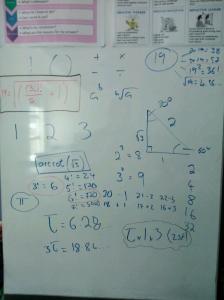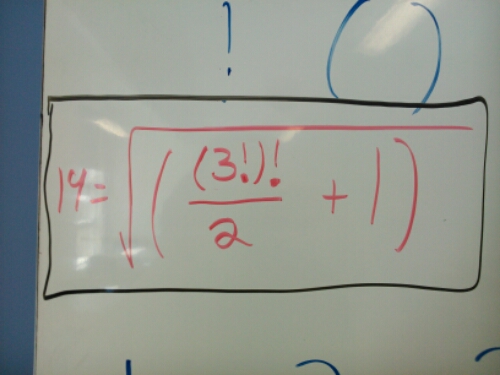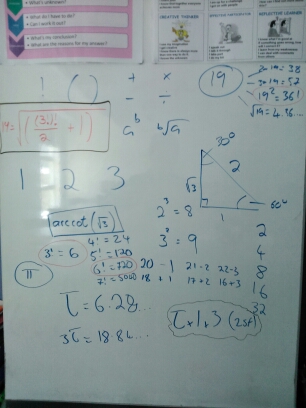A Fiendishly Hard Puzzle
In keeping with the apparent theme of this holiday, I have another fiendishly difficult puzzle for today. This one came about in a peculiar way, I have been reading over all the old “Carnival of Maths” posts, starting with issue 1. These are from way back in 2007. In issue 10 I came across this post which is a rather interesting variation on the well known 4 4’s task. I liked the link, so I tweeted it, and I got the following tweet back from Colin Beveridge (@icecolbeveridge):
I played around with a number of ideas mentally, I checked it was possible (I assure you it is) and I checked it wasn’t a sneaky lateral thinking puzzle where you put the 1 as the tens digit then 9 (ie 3^2) as the units. After confirmation that it wasn’t a trick I tried out a few things. I would urge you to have a go yourself before reading on. Go on, you know you want to!
Have you got an answer? Have you checked your working?
Good, then we shall proceed!
My thought process was quite sporadic and jumpy, at first I thought that there might be something with an inverse trig function such as arcsin but after playing with them for a bit I did find (arcsec(2)/3)-1) in degrees, but I was assured there was a way with no lettering. I then thought we might need to use factorials or subfactorials, Colin tweeted this:
Which did throw me off the scent a little. I wondered if Pi was classed as a mathematical symbol, and if the trick was to use that. After all, if Colin had mean any mathematical operation, surely he would have used the correct word?!
I thought a little about it, noticed that tau is roughly 6.3, and that 3tau is roughly 19, so I tried “taux1x3 (2sf)”. A valid answer, but I wasn’t happy with it, and Colin confirmed that it too included too much lettering.
MR H (@singinghedgehog) then tweeted this nice effort:
It does, of course, involve switching to radians between the sine and the arcsine. Both Colin and I liked it, but it wasn’t the answer. I continued toiling away, wrote most of the things I knew on my whiteboards and took a step back.
Here is a photo of my whiteboard once I had finished the task:
I was working in blue to begin with, you can see some of my thoughts around triangles, arccot’s before I saw the arcsec, and had my lettering ideas dashed. You can see where I came up with my tau answer down at the bottom and you can see my final answer in red in a black box up towards the top left. I had written out the factorials up to seven a while before, but had moved away from that line of thinking after Colin’s triple factorial tweet had thrown me off the scent. Just before I stepped back I had written the bit at the top right around 19, to see if I could go backwards. When I did step back the thing that struck me I circled in red. 361 is about half of 720. In fact it is exactly one more than 720, and I have a 2 and a 1. And Using (3!)! I can get to 720 without using the 1 or the 2. Fantastic! What a lovely answer. 19 = root(((3!)!)/2)+1)



This is awesome! Well done!
Each year in school we’re giving the challenge to use all the digits in the year (eg 2,0,1,4 for 2014) and see how far we get. This year’s one was fun. But just a quick question..if you could answer? Over the internet I’m getting varied answers. So you know how a factorial does this, for example 3! is 6, but what is double factorial? Sorry if It’s obvious, but surely wouldn’t it be a huge number?
3! Is 3X2x1=6 for (3!)! As in the solution you evaluation the bit in brackets first so get 6! =6x5x4x3x2x1 = 720
That makes sense. But if we had say…five. 5!!. Is it true that that means 5x3x1?
Yes, that’s the double factorial, sometimes known as odd factorial.
There is a double factorial (or odd factorial) which is defined as the product of the odd integers, ie 8!!=1x3x5x7=105
Hey that’s cool! Thank you very much for answering my question. 🙂
More on the multifactorial here: http://mathworld.wolfram.com/Multifactorial.html
Excellent puzzle. Even though I am more than a year too late, how about this:
1/ [Sum over t=1 to 3! of x(t) ] -2. I can’t easily insert mathematical symbols here, so that is a lengthy way of representing the sigma (denoting summation). So this would yield 1+2+3+4+5+6-2=19.
Another, more abstruse one is this:
2/ [Sum over n=Gamma(k) to k of {tetration superfix n to the base 2} ] – 1; where k=3.
This would yield first a summation over the range of Gamma(3)=2!=2 to 3 of some function.
The function is “tetration to the base 2”, ie the next hyperoperator after exponentiation. So we have [2 tetration base 2 + 3 tetration base 2], which is 2^2 + 2^(2^2), which is 4 + 16 = 20. From which we deduct 1 to get 19. Note that tetration is non-associative.
🙂
Love it!
How about [ Sum from t=1 to 3! of x(t) ] -2. I have not found out yet whether I can insert mathematical symbols here, but this is just a lengthy way of writing 1+2+3+4+5+6+-2=19.